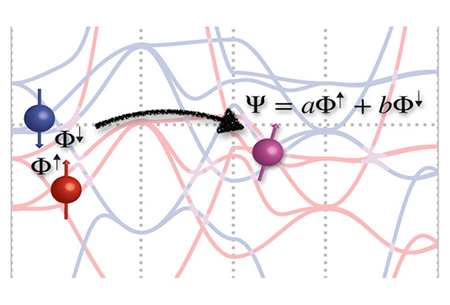| Nov 22, 2021 |
Spin mixing in ferromagnets revealed
(Nanowerk News) For the first time through experiments and theory, Uppsala researchers, together with international collaborators, have been able to measure spin mixing in a ferromagnetic material (Physical Review Letters, "Quantifying Spin-Mixed States in Ferromagnets"). Through the experimental measurements, they discovered that a common factor in spin equations, in common use since the 1950s, has been significantly underestimated.
|
 |
| For the first time researchers have been able to measure spin mixing in a ferromagnetic material. (Image: Ronny Knut)
|
|
In addition to the well known electric charge, electrons have a magnetic moment, also called spin. The spin can in a simplified way be described as the micro-level equivalent to the macro-level bar magnet, which has a north pole and a south pole.
|
|
An important phenomenon in quantum mechanics is that the spin can have more than one value at the same time, a so called spin mixing, which is in sharp contrast to classical mechanics. One may compare this with the thought experiment Schrödinger’s cat, which is both alive and dead at the same time until one makes an investigation.
|
|
“Spin mixing is a bridge which makes it possible for the spin to quickly switch direction and might be important for future spin electronics. You want a low spin mixing when the spin should be unchanged, when the spin is used as bearer of information. Instead you want a high spin mixing when you quickly want to affect the spin, as for example in the case of ultra-fast demagnetisation of a material,” says Ronny Knut, researcher at the Department of Physics and Astronomy.
|
|
The mixing of different states of the spin in a material may be estimated from calculations, but there has until now been no good experimental method to measure this effect.
|
|
What the Uppsala researchers have discovered is that equations from the 50s, which today are used to describe how spin behave in a microwave field, have underestimated the importance of spin mixing and that a correctly matched equation instead may be used for measurements of this.
|
|
The researchers have arrived to the results by using two different measurement methods that have given different results, Ferromagnetic resonance (FMR) carried out at NIST in Boulder and X-ray magnetic circular dichroism (XMCD), carried out at the synchrotron BESSY II in Berlin. The answer to the differences between the both measurement methods has been derived from the factor in the theoretical model that has previously been disregarded. Now it has been realised that it still plays a role and that the difference between FMR and XMCD is directly related to the spin mixing.
|
|
“This work will make possible methodical studies of spin mixing, which will carry the development of spin electronics forward,” says Ronny Knut.
|
|
The equation developed by the physicist Charles Kittel is one of the most well-known relationships used within modern magnetism and is the basis of thousands of publications of magnetic phenomena. When Kittel derived his equation he chose to disregard a contribution which he assumed had no practical significance at the time. The disregarded contribution is an extension of Kittel’s original application of the laws of quantum physics, which assumes that the behavior of electrons and their spins are described by wave functions that follow strict quantum mechanical rules.
|
|
Uppsala University has contributed with both experiment (Ronny Knut and Olof Karis) and theory (Yaroslav Kvashnin, Erna K. Delczeg-Czirjak and Olle Eriksson). The research has been carried out in a collaboration with researchers from NIST in Boulder (USA), The University of South Florida in Florida (USA), Örebro University, Trinity College in Dublin (Ireland) and Helmholz-Zentrum Berlin (Germany).
|

